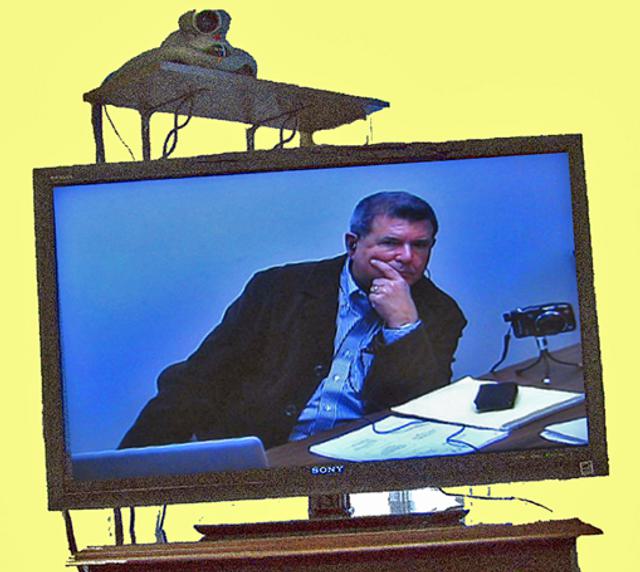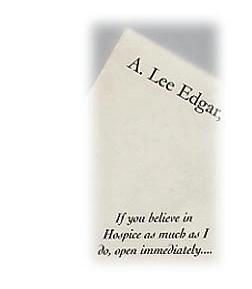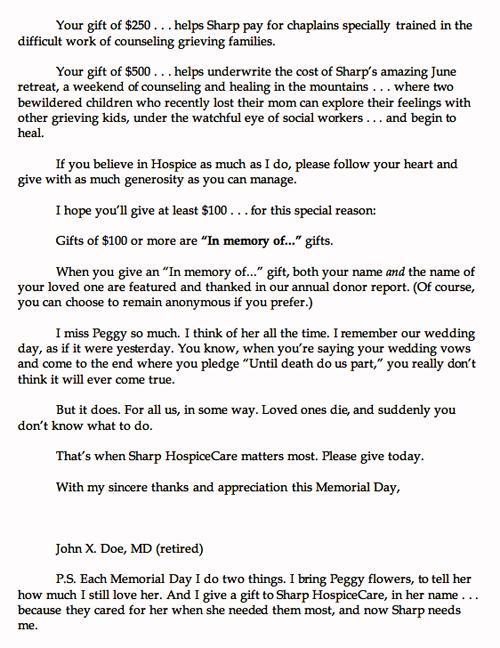How I wrote it: the Sharp HospiceCare conversion letter
In the first of this SOFII series of interviews with leading fundraising writers, Fergal Byrne talks to Tom Ahern about a letter he wrote in 2002 for Sharp HospiceCare. Here Tom tells Fergal how he wrote this letter, explains his approach and takes us through the letter step by step.
- Written by
- Fergal Byrne
- & Tom Ahern
- Added
- July 17, 2010
The challenge

The challenge was to convert donors who had made a one-off memorial gift to Sharp HospiceCare, in honour of a deceased friend or loved one, into what you might call a ‘real donor’, someone who recognises Sharp HospiceCare and wants to contribute to and support its cause.
What happened
This letter became the control for the hospice, the benchmark against which new promotions were tested, for about seven years. It was also used by many other hospices in the US.
Background work
Before starting work on any letter, Tom Ahern does some research, to get to know the client better and to identify any good stories to be used in the letter. He uses existing material about the charity – brochures, case studies, videos, etc. Tom has also been inspired by some books on fundraising (Mal Warwick’s Successful Fundraising Letters and Alan Sharpe’s books, amongst others).
‘Direct mail copywriting is so filled with little things that you have to get right,’ he says. ‘I want to make sure I’ve got a checklist available at my elbow so I’m not going to miss anything.’
Next comes the concept stage – to find the governing idea or theme of the promotion. ‘I go through a half dozen concepts first. It doesn’t take me very long, but I’ll generate lots of different ideas. I realise, of course, that lots of these ideas won’t work so I try a bunch of things, and hope to avoid dead ends.’
The concept here was pretty simple. He explains, ‘The hospice told me that they had a doctor whose wife had been looked after by before passing away – and that he was willing to lend his signature to the letter. I decided later that the letter should be sent out on Memorial day.’
Once he had decided on the overall concept for the letter, Tom worked, ‘to get the structure of the letter nailed down – in other words, what’s first, second, third, what comes at the end, and how it all works with the reply device and the envelope. So everything is working together as an integrated package.’
Finally, come the words. ‘Once I have figured out the structure, then I can get into the wordsmithing, choosing the right words and turns of phrase and trying to create flawless transitions, I am trying to create something that just glides through the reader’s mind without any obstacles, I want to it to flow.’
Kneading the emotional dough
Before starting work on the letter, Tom wrote down half a dozen or so of what he calls ‘emotional triggers’, guidelines to help him start thinking in the right channels. These are emotions like salvation, fear, hope, duty, faith.
The goal is to make sure there is a strong emotional connection with the reader throughout the letter. ‘I want every paragraph, every sentence to be working the emotional dough, kneading it, kneading it, kneading it.’
Who to write to?
Many experienced copywriters talk about the importance of having a particular reader in mind when they write a fundraising letter. Tom agrees, ‘You really have to envision the person on the receiving end. Although I maybe writing “Dear John”, I’m really writing to myself. If I’m not convincing myself, I’m not going to convince anyone else. So I have to feel the hairs on the back of my neck going up a little when I read this letter.’
Tom uses his own personal experiences when writing a fundraising letter. ‘You tap into whatever you have that allows you to penetrate and create real emotions. These are not artificial, these are not plastic flowers. I am trying to reach into real emotions that I have had.’
In this case, it was Tom’s father’s emotions following the death of his wife (Tom’s mother). ‘I had witnessed my father becoming a widower. And I really was thinking of his feelings, how I saw him act after that.’
Opening mail over the bin

One American copywriter said that Americans open their mail over the bin, looking for a reason to throw things away. Using the marketing framework AIDA, (attention, interest, desire, action) as a basis for structuring the letter, Tom wanted to make sure he got the readers’ attention right from the beginning. ‘It all starts with attention, so I’m thinking this letter has got to land in their mail, in their house – what might cause them not to throw it away?’
He started with the envelope, exploring possible emotional triggers he had generated earlier. ‘I asked myself: how might I express salvation? That’s why the teaser copy on the envelope said: if you believe in hospices as much as I do. Here I am using pronouns consciously: the words you and I. I am in effect previewing the two voices of the letter.
‘My aim here is to use the word belief to stimulate a question. I want the readers to ask themselves the question – and say yes, I do believe in hospices. Once they have agreed, they are a little bit on the hook,’ adds Tom.
‘The goal is to get the reader to mentally nod her head yes, with every line,’ he says. ‘As Mal Warwick says his book, we are really having a conversation – and the reader is either agreeing with me or not agreeing. If she is not agreeing with me she is not going to get her cheque book out and write a cheque.’
The only other information on the envelope is the name of the hospice and the name of the doctor who signed the letter: ‘The doctor’s name added a little weight because people trust doctors, feel more of an obligation to open it,’ he says. ‘And the purpose of the envelope is of course to get the letter opened.’
Frustrated dramatist
‘The story in this letter is pretty minimal: the letter is sent by the doctor,’ says Tom. ‘You are not the signatory so you need to pretend to be someone else. And on your best days you do, you become the person, and, that day, I was him: I had lost my wife.’
At the same time the writer needs to be someone who understands and respects technical aspects of direct mail. ‘So it not about getting the real voice of the doctor right – it’s about telling a very simple story very quickly, and the doctor and his title serve a purpose. It helps to be a frustrated dramatist.’
Tom chose to date the letter on Memorial day because of its significance in the US. ‘Memorial day is the day of the dead essentially – people go to the cemetery, people go and clean graves, that kind of thing, it’s a big holiday on the calendar. So we decided to hang this appeal on Memorial day – it seemed consistent with honouring the dead.’
How long should the letter be?
Many experienced copywriters strongly believe that longer is better when it comes to direct mail. And four-page letters tend to be the default choice by fundraisers when it comes to to recruiting new donors by letter.
‘We did consider the possibility of writing four pages, but frankly, there wasn’t enough to write about. There is a kind of rough guideline: write as much as you need to. I felt that the doctor’s story was good, emotionally tight and well-grounded and we didn’t want to clutter it up with a lot of extra information.’
The letter: analysis
It’s essential that a fundraising letter is easy to read, appealing, draws the reader in and keeps him reading. Tom used a couple of strategies in this letter. Layout is important. ‘It starts off with some very short paragraphs, which are visually easy to absorb and that say things that I am hoping the reader agrees with,’ he says.
And plenty of ‘yous’. The word you is peppered throughout the letter. ‘The reader is coming across yous everywhere: it helps keep him glued to the page. When I’m writing I stop every 20 or 30 minutes and I select all the yous in the letter on my computer and I change them from black to red, so I can easily see them. If there are any paragraphs without ‘you’, I tend to rewrite them.
‘We hold dear… Here I am trying to embrace the readers, I don’t want anything pushing them away, I’m trying to draw them in.
‘My wife died of cancer. Frankly this is here to stun the reader. It’s a simple statement, but it’s kind of shocking: they were together so long.
‘Thanks to the people at Sharp HospiceCare… This section is there just to remind them what’s so wonderful about the hospice. I am hoping that the reader agrees how wonderful hospices are. This really came out of my experience and, as I do a lot when I write direct mail, I tried to reach into what I know emotionally. Donors love the idea of helping to relieve pain.
‘Sometimes you need to explain in detail what a charity does; sometimes you need to explain less. Here the message is: you are mortal – I hope you feel this message somewhere in your soul.
‘Here is something you might know… I make sure I am using a conversational tone – all fundraising copy should sound like a conversation. The point I am trying to make here is that people don’t always realise that the organisation relies on charity.
‘Also, it is important to create a place for the donor to stand, to show that the donor is essential. I want to say to the reader: without your help we can’t do this… to make sure he understands that the hospice is a charity.
‘People who might give you a gift must feel proud of what they are about to do and also feel something stirring in them. I want to use any memories the people receiving this letter might have; after all, they have already made a memorial gift. I am trying to reconnect them with that moment.
‘Helping other families cope successfully with the suffering, confusion, doubts and fear… Here we are back to emotions again: help people who have doubts, help with confusion. I am using these words, not because I am trying to describe technically what the hospice is, but rather to describe it emotionally – giving the reader an emotional reference that they can identify with.
‘Your gift of $25…. I am not sure whether this section outlining the exact use the money would go to is the best part of the letter or not. I did it because it filled some space. It also gave me a chance to say “your gift of…” repeatedly, and that is an implied ask.
‘Although, I haven’t used the words ask, or give, or donation, I’m basically putting the idea of giving into the readers’ heads. I also wanted to make sure they understood that small gifts were meaningful too.
‘I hope you’ll give at least $100… I am singling out this figure because the hospice knows from previous experience that’s what the donor is going to give on average. So we celebrate it, instead of hoping to push her into some higher category by circling a larger amount. That’s a key part of understanding the psychology of the person on the receiving end. You really want to get out of your own head.
‘When you are looking for new donors it’s not appropriate to try and bump up the donation: they’re just trying to decide whether they want to go out on a date with you or not. This is not the time to start pressing hard. What you want to do is make them feel very, very special if you can.
‘In every letter, you have to ask – and often. In general I try to get four asks into each letter. This was written when I wasn’t asking so ruthlessly; today, I would certainly ask more often.
The PS
‘I should have been arrested for criminal assault on the readers’ feelings in the PS at the end of the letter.
‘Each memorial day I do two things. I bring Peggy flowers to tell her how much I still love her and I give a gift to the hospice in her name.
‘The aim here is to try and get the reader to model the doctor’s behaviour.’
© Fergal Byrne 2010



















